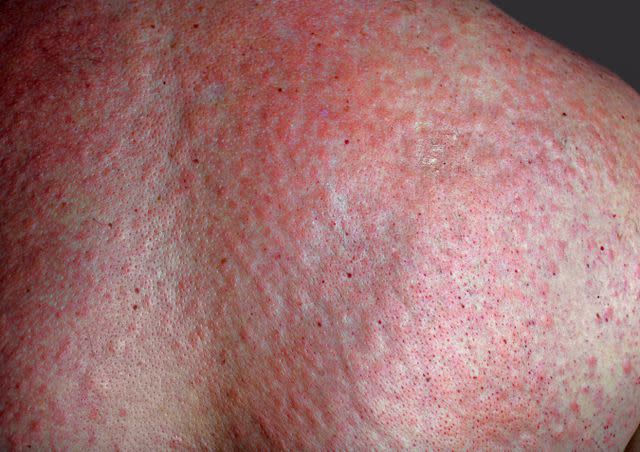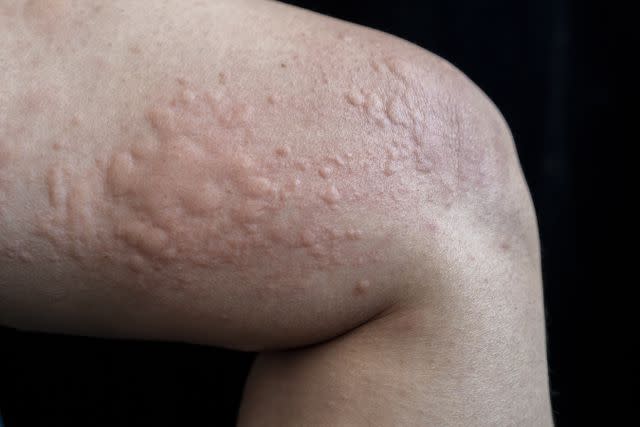What Are Hives (Urticaria)?
Medically reviewed by William Truswell, MD
Hives (urticaria) is an inflammatory skin condition that causes bumps, or wheals, to form on the skin. Urticaria can occur with symptoms like angioedema (swelling) and headaches.
Hives arise due to the activity of skin cells and the release of histamine. Your immune system releases this chemical in response to an allergen, which causes symptoms. These symptoms typically resolve on their own within one week. Some people develop chronic urticaria, in which flares recur regularly after six weeks of onset. Treatments for hives include managing symptoms and steering clear of any triggers.
About 20% of people experience hives at some point in their life. Hives can significantly impact your quality of life, but several successful therapies exist to reduce symptoms. Read on to learn about hives, including types, symptoms, treatments, and more.
Related: What Is Heat Rash?
Types of Hives
Hives cases are primarily classified based on the cause and how long they persist. There are several classifications: acute, chronic spontaneous, and inducible urticaria. The classification influences the treatments for hives.
Acute Urticaria
Acute urticaria refers to cases that resolve on their own within six weeks of initial onset. About two-thirds of all hives cases are acute. The causes of this type are usually unknown (idiopathic). Symptoms can also arise due to allergic reactions or an underlying infection.
Chronic Spontaneous Urticaria
Hives are chronic if symptoms persist longer than six weeks. Most of these cases are chronic spontaneous urticaria, in which the issue is idiopathic. Healthcare providers usually cannot identify a specific trigger or cause. About 1% of people in the United States have this type of hives.
Inducible Urticaria
Inducible urticaria, or physical urticaria, arises due to an identified trigger or external factor. Common triggers include:
Allergens (e.g., pet dander)
Cold
Exercise
Heat
Pressure on the skin
Water or being wet
Wearing or touching latex
Inducible urticaria can impact people of all ages. About 20% to 30% of chronic hives cases are inducible.
Hives Symptoms
Hives can present with a variety of symptoms, including wheals, angioedema, and itching. You might also develop systemic symptoms, such as headaches and nausea.
Wheals
The primary feature of hives is round, oval, or irregularly shaped welts on the skin, or wheals. Wheals are generally reddish or darker in color and temporarily turn white when you press on them. If you have a darker skin tone, hives typically appear the same color as or slightly darker or lighter than your natural skin color.
Wheals range in size from less than 1 to a couple of centimeters (cm). The welts set on rapidly—within minutes to hours—resolve on their own within 24 hours and leave no mark.
You might develop wheals anywhere on your body. Wheals are typically more prevalent in areas under pressure from clothing or on skin that regularly comes into contact with other skin. Hives do not cause pain. Eruptions may cause severe itching (pruritis), typically most severe at night.

MediaProduction / Getty Images
Angioedema
Angioedema, or patches of swelling under the skin, occurs with wheals in about 40% of hives cases. This issue can even arise independently in some cases. This swelling most often affects the area around the eyes, lips, hands, feet, and throat. Angioedema arises quickly and can cause abdominal cramps and difficulty breathing.

HengDao / Getty Images
Itching
Itching is a common symptom of hives, occurring with or without wheals. Some people only develop itching.
Itching most commonly occurs with chronic hives but can happen with any type. Physical triggers, such as extremely hot or cold temperatures, can sometimes worsen itching.
Headache and Other Systemic Symptoms
The impact of hives is primarily seen in the skin. A small subset of people with chronic spontaneous urticaria can develop additional symptoms, such as:
Abdominal pain
Flushed skin
Heart palpitations
Nausea and vomiting
Swelling in the joints
Wheezing or breathing difficulties
Quality of Life
Hives can affect your appearance and cause itchiness, which can significantly impact your quality of life. Itching is often worse at night, so you may have difficulty falling or staying asleep. Symptoms can also impact daily life and performance at work or school.
What Causes Hives?
Hives is an inflammatory reaction of the skin. Symptoms arise due to the activation of mast cells. These skin cells trigger your body's immune response. Mast cells trigger the release of histamines and antibodies, which cause itching and swelling.
Several causes can lead to this skin reaction. Acute cases can be set off by allergic reactions to certain foods and drinks, direct contact with some plants (e.g., stinging nettles), and some medications. Non-steroidal anti-inflammatory drugs (NSAIDs), for example, may trigger hives.
It's not exactly clear what causes chronic spontaneous urticaria. Exposure to physical triggers, such as latex, heat, cold, and wetness, can result in inducible urticaria.
Risk Factors
Hives can affect anyone. Certain factors can increase your risk of hives:
Age: Acute hives are most prevalent in children younger than 5 and infants.
Autoimmune disorders: Having rheumatoid arthritis or thyroid disease may increase your risk of hives. Rheumatoid arthritis causes painful and stiff joints. Thyroid disease affects the butterfly-shaped gland in the center of your neck, which releases hormones.
History of allergies: Those with allergies or who have had hives before are more likely to develop urticaria than others.
Family history: Genetics seems to play a role. Having close relatives with urticaria can increase your chances.
Sex: Females are more likely to develop hives than males.
Stress: Some people develop hives as part of a physical response to stressful situations, making high stress a risk factor.
How Are Hives Diagnosed?
Diagnosing hives typically involves clinical evaluation of symptoms and medical history. A dermatologist (healthcare providers who specialize in the skin, hair, and nails) will visually assess wheals or angioedema. They will determine your overall health by measuring heart rate, body temperature, blood pressure, and breathing.
The dermatologist may also test dermographism, or a primary sign of hives. Dermographism is when wheals form within minutes after applying pressure to your skin. The dermatologist typically uses the blunt side of a pen or tongue depressor to test dermographism.
Wheals typically disappear within 24 hours. A dermatologist will circle bumps with a pen and ask you to come back and see if there are any changes.
Other diagnostic tests may include:
Blood tests: Complete blood count (CBC), erythrocyte sedimentation rate (ESR), and allergen-specific immunoglobin (IgE) are blood tests that screen for inflammation.
Challenge testing: A healthcare provider will assess skin responses to certain stimuli to test for inducible urticaria. These stimuli include exposure to cold, water immersion, heat, and pressure on the skin.
Skin prick test: Allergic reactions can cause hives, so a healthcare provider may use a skin prick test to test for allergies. They will inject a small amount of an allergen into your skin and assess the extent of swelling after 15 minutes.
Treatments for Hives
The majority of hives cases are acute and resolve on their own. If you have chronic hives, you may require additional and more sustained therapy. The goal of treatments for hives is to avoid triggering flares and ease itching and discomfort. You may employ strategies.
Antacids
People typically use antacids, or acid reducers, to treat acid reflux and heartburn. You may also use antacids to manage hives. Histamines that trigger hives also stimulate cells in the stomach, producing excess stomach acid.
A healthcare provider will usually prescribe antacids for hives in combination with antihistamines. Common antacids include Pepcid (famotidine) or Tagamet (cimetidine).
Antihistamine Medications
Antihistamines are a class of anti-allergy medications that ease the inflammatory process at the root of hives symptoms. A healthcare provider may advise you take an over-the-counter (OTC) antihistamines if you have acute hives.
You might require prescription antihistamines if you have chronic or severe hives. These antihistamines include:
Allegra (fexofenadine)
Benadryl (diphenhydramine)
ChlorTrimeton (chlorpheniramine)
Claritin (loratadine)
Vistaril (hydroxyzine)
Zyrtec (cetirizine)
Corticosteroids
If antihistamines are not yielding results, a healthcare provider may prescribe another class of medication called corticosteroids. Common corticosteroids include prednisone and hydrocortisone. You may use this therapy alongside other drugs, such as antihistamines.
Other Medications
An allergist or dermatologist may prescribe the biologic Xolair (omalizumab) if other medications have not succeeded. This type of drug is a monoclonal antibody with an anti-inflammatory effect that can ease symptoms. Leukotriene-receptor antagonists, such as Singulair (montelukast) and Accolate (zafirlukast), may have a similar effect.
Trigger Avoidance
A healthcare provider can help you develop strategies to avoid triggers like heat, cold, or direct sunlight. You might need to modify certain lifestyle factors. Avoiding alcohol, which can worsen symptoms, and medications like NSAIDs can help.
How To Prevent Hives
There may be ways to prevent the onset of hives and limit flares. Prevention strategies include:
Prioritizing mental health: Stress can trigger hives, so developing means of relaxation may help. Practicing meditation or yoga, exercising, and getting quality sleep may help.
Talking to a healthcare provider: Consultation with an allergist or dermatologist to confirm your diagnosis and begin treatment can go a long way in easing symptoms.
Tracking flares and triggers: Keep a record of your symptoms and what set them off. Try to avoid triggers as well as you can. Steer clear of alcohol and certain medications like NSAIDs.
Related Conditions
Having hives, especially chronic types, has been linked to a high risk of other health concerns. Related conditions include:
Asthma: This respiratory disorder causes attacks of severe breathing difficulties and wheezing. Asthma rates are higher among those with chronic urticaria than others. Both health conditions are linked to elevated levels of immunoglobulin E (IgE) antibodies, which are part of an inflammatory response.
Atopic dermatitis (eczema): This skin condition causes dryness, flakiness, and brittleness. Eczema and chronic hives both involve an overactive immune response.
Autoimmune disorders: The risk of thyroiditis and vitiligo may increase among people with chronic hives. Thyroiditis is inflammation of the thyroid. Vitiligo causes the loss of skin color, which develops in patches.
Depression and anxiety: Chronic hives can disrupt the quality of life, including an impact on self-image that affects mental health.
Diabetes: This causes your body to not use insulin (a hormone that moves sugar into cells) as normal. The exact link between hives and diabetes is unknown, but both involve high mast cell activity.
Osteoporosis: Hives may be linked to osteoporosis, which causes weak and brittle bones. Similar allergic and immune processes occur with both disorders.
Rheumatoid arthritis: Rheumatoid arthritis occurs when the immune system mistakenly attacks the joints, causing painful swelling and inflammation. This increased immune activity may lead to hives.
Related: What Is a Maculopapular Rash?
Living With Hives
Hives can be very uncomfortable, but they rarely are dangerous. Acute cases are self-limiting and go away on their own. Only in cases of severe allergic reactions are hives life-threatening.
Chronic hives can significantly impact mental health and well-being. Urticaria may cause sleep problems, fatigue, and difficulty concentrating. People with hives might have a higher risk of anxiety and depression as a result.
Treatments are highly successful in managing hives. Be sure to talk to a dermatologist or allergist if you have persistent symptoms. Carefully follow a treatment plan, and avoid triggers as much as possible. You'll be better able to manage symptoms and prevent flares over time.
For more Health.com news, make sure to sign up for our newsletter!
Read the original article on Health.com.

